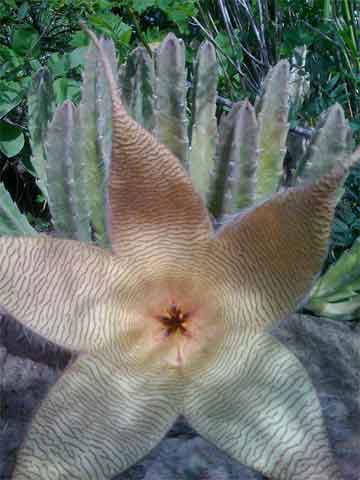“As fragrant as a flower,” is an expression often used, but definitely does not apply to flowers of any of the several species of the stapelia, (sta-PEE-li-a) better known by such names as: starflower of Africa; starfish flower, carrion flower and rotten-egg plant.
Blossoms of these plants range in size from those of the S. gigantea which measure a foot or more across, to the ones of the dwarf Stapelia pulchella, less than one inch across. The flowers also enjoy a wide color range from fawn to sulfur-yellow, through shades of coppery-red to purplish-black, marked with lines, bars and spots of contrasting hues. Flowers of the Stapelia hirsuta, or shaggy stapelia, arc covered with a dense growth of fine hairs, while those of Stapelia variegata shine beautifully in the dark.

Despite considerable difference in size and color, the flowers of most stapelias have common characteristics in that each is leathery-textured and emits a putrid odor highly suggestive of spoiled meat or over-ripe hen fruit. Just one whiff from a flower and it is easily understandable how the common names of carrion and rotten-egg originated.
The names of starflower and starfish are also self-explanatory because of the shape of the blossoms and because the plants are natives of South Africa.
There are really two stars in the flowers of the S. variegata, S. hirsuta, and some of the others. One star is formed by the five petals, then in the round base in the center is another small, but clearly defined star. However, S. bicolor has only four petals, and a square base to its flower star.
Stapelias seldom bloom except in summer and autumn, at which time the plants arc usually on the outside, or can be set outside, where the stench is highly pleasing to flies which spread pollen from one to another. The plant is dependent on flies for its pollination and the odor attracts the insects both day and night. However, they seem to swarm about Stapelia variegata in even greater numbers in the dark when its glow adds to its attractiveness.
The Odor
Much has jokingly been said about the odor of the flowers, which really is not too unpleasant, especially for the first two days after opening. And anyone with true appreciation for exotic plants will derive much pleasure in watching the flower develop from a five-sided, flat-topped floral bud. Several days pass from the time the bud first appears until the opening of the flower, which has a life span of several days.
After the flower withered and fell from one of my plants, a formation somewhat similar to that of the floral bud remained. For ten months the form remained the same. Then it started expanding and within a month a pod some three or four inches long developed. Turning yellow and splitting down the center, it freed many brown, flat plumed seeds, very similar to those of the common milkweed.
A plant, (depending on species) may be sprawling, or vine-like, or erect, standing eight inches, or maybe a mere two or three inches in height. However, all species have artistic, leafless, toothed, fleshy stems, bearing a striking resemblance to joints of cacti. It bears no resemblance, (other than its seeds and pods) to the milkweed family, of which it is a member.
Generally speaking these plants are treated much like other potted succulents. They grow best in a mixture of one-third each of leaf mold, sand, and garden soil. (If soil is principally sand or gravel, add a little humus without manure content.) Good drainage is of prime importance.
The stapelia should be moderately watered during the growing season, but kept on the dry side during the winter months. It requires sunlight, and will do well in east, south or west windows. In the spring when danger of frost has past, set the pot outside where it will get full sunlight. In winter months it is quite tolerant and does well with a daytime temperature from 65 to 70 degrees, and 45 degrees, or lower at night will not damage it.
New plants may be started during any season from cuttings, which should be set in moist (not wet) sand or ordinary garden soil.
A four-inch pot, even for the Stapelia gigantea, will accommodate a plant comfortably for one season. It is no trouble to repot, and if given ordinary care, one plant will live indefinitely.



{ 0 comments… add one now }
You must log in to post a comment.